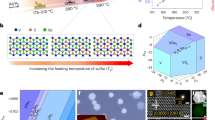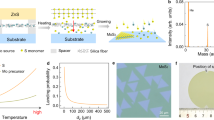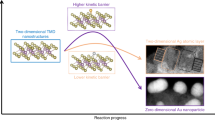Abstract
Chemical functionalization of low-dimensional materials such as nanotubes, nanowires and graphene leads to profound changes in their properties and is essential for solubilizing them in common solvents. Covalent attachment of functional groups is generally achieved at defect sites, which facilitate electron transfer. Here, we describe a simple and general method for covalent functionalization of two-dimensional transition metal dichalcogenide nanosheets (MoS2, WS2 and MoSe2), which does not rely on defect engineering. The functionalization reaction is instead facilitated by electron transfer between the electron-rich metallic 1T phase and an organohalide reactant, resulting in functional groups that are covalently attached to the chalcogen atoms of the transition metal dichalcogenide. The attachment of functional groups leads to dramatic changes in the optoelectronic properties of the material. For example, we show that it renders the metallic 1T phase semiconducting, and gives it strong and tunable photoluminescence and gate modulation in field-effect transistors.
This is a preview of subscription content, access via your institution
Access options
Subscribe to this journal
Receive 12 print issues and online access
$259.00 per year
only $21.58 per issue
Buy this article
- Purchase on Springer Link
- Instant access to full article PDF
Prices may be subject to local taxes which are calculated during checkout





Similar content being viewed by others
References
Wang, Q. H., Kalantar-Zadeh, K., Kis, A., Coleman, J. N. & Strano, M. S. Electronics and optoelectronics of two-dimensional transition metal dichalcogenides. Nature Nanotech. 7, 699–712 (2012).
Jaramillo, T. F. et al. Identification of active edge sites for electrochemical H2 evolution from MoS2 nanocatalysts. Science 317, 100–102 (2007).
Voiry, D. et al. Enhanced catalytic activity in strained chemically exfoliated WS2 nanosheets for hydrogen evolution. Nature Mater. 12, 850–855 (2013).
Lukowski, M. A. et al. Enhanced hydrogen evolution catalysis from chemically exfoliated metallic MoS2 nanosheets. J. Am. Chem. Soc. 135, 10274–10277 (2013).
Voiry, D. et al. Conducting MoS2 nanosheets as catalysts for hydrogen evolution reaction. Nano Lett. 13, 6222–6227 (2013).
Ataca, C. & Ciraci, S. Functionalization of single-layer MoS2 honeycomb structures. J. Phys. Chem. C 115, 13303–13311 (2011).
Chhowalla, M. et al. The chemistry of two-dimensional layered transition metal dichalcogenide nanosheets. Nature Chem. 5, 263–275 (2013).
Py, M. A. & Haering, R. R. Structural destabilization induced by lithium intercalation in MoS2 and related compounds. Can. J. Phys. 61, 76–84 (1983).
Heising, J. & Kanatzidis, M. G. Structure of restacked MoS2 and WS2 elucidated by electron crystallography. J. Am. Chem. Soc. 121, 638–643 (1999).
Eda, G. et al. Photoluminescence from chemically exfoliated MoS2 . Nano Lett. 11, 5111–5116 (2011).
Eda, G. et al. Coherent atomic and electronic heterostructures of single-layer MoS2 . ACS Nano 6, 7311–7317 (2012).
Tasis, D., Tagmatarchis, N., Bianco, A. & Prato, M. Chemistry of carbon nanotubes. Chem. Rev. 106, 1105–1136 (2006).
Hirsch, A. Functionalization of single-walled carbon nanotubes. Angew. Chem. Int. Ed. 41, 1853–1859 (2002).
Quintana, M., Vazquez, E. & Prato, M. Organic functionalization of graphene in dispersions. Acc. Chem. Res. 46, 138–148 (2013).
Liang, F. et al. A convenient route to functionalized carbon nanotubes. Nano Lett. 4, 1257–1260 (2004).
Voiry, D., Roubeau, O. & Pénicaud, A. Stoichiometric control of single walled carbon nanotubes functionalization. J. Mater. Chem. 20, 4385–4391 (2010).
Syrgiannis, Z. et al. Reductive retrofunctionalization of single-walled carbon nanotubes. Angew. Chem. Int. Ed. 49, 3322–3325 (2010).
Chakraborty, S., Chattopadhyay, J., Guo, W. & Billups, W. E. Functionalization of potassium graphite. Angew. Chem. Int. Ed. 46, 4486–4488 (2007).
Englert, J. M. et al. Covalent bulk functionalization of graphene. Nature Chem. 3, 279–286 (2011).
Jiang, S. et al. Improving the stability and optical properties of germanane via one-step covalent methyl-termination. Nature Commun. 5, 3389 (2014)
Canfield, D. & Parkinson, B. A. Improvement of energy conversion efficiency by specific chemical treatments of molybdenum selenide (n-MoSe2) and tungsten selenide (n-WSe2) photoanodes. J. Am. Chem. Soc. 103, 1279–1281 (1981).
Chou, S. S. et al. Ligand conjugation of chemically exfoliated MoS2 . J. Am. Chem. Soc. 135, 4584–4587 (2013).
Heising, J. & Kanatzidis, M. G. Exfoliated and restacked MoS2 and WS2: ionic or neutral species? Encapsulation and ordering of hard electropositive cations. J. Am. Chem. Soc. 121, 11720–11732 (1999).
Golub, A. S., Zubavichus, Y. V., Slovokhotov, Y. L., Novikov, Y. N. & Danot, M. Layered compounds assembled from molybdenum disulfide single-layers and alkylammonium cations. Solid State Ion. 128, 151–160 (2000).
Joensen, P., Frindt, R. F. & Morrison, S. R. Single-layer MoS2 . Mater. Res. Bull. 21, 457–461 (1986).
Yang, D. & Frindt, R. F. Li-intercalation and exfoliation of WS2 . J. Phys. Chem. Solids 57, 1113–1116 (1996).
Socrates, G. Infrared and Raman Characteristic Group Frequencies: Tables and Charts (Wiley, 2001).
Aynsley, E. E., Greenwood, N. N. & Sprague, M. J. The oxidation of potassium selenocyanate by iodine pentafluoride. J. Chem. Soc. (Resumed) 704–708 (1964).
Khan, M. A. & Raees, H. ChemInform abstract: synthesis of a new bis-harmine selenide. ChemInform 28, 1779–1780 (1997).
Mak, K. F., Lee, C., Hone, J., Shan, J. & Heinz, T. F. Atomically thin MoS2: a new direct-gap semiconductor. Phys. Rev. Lett. 105, 136805 (2010).
Splendiani, A. et al. Emerging photoluminescence in monolayer MoS2 . Nano Lett. 10, 1271–1275 (2010).
Tongay, S. et al. Defects activated photoluminescence in two-dimensional semiconductors: interplay between bound, charged, and free excitons. Sci. Rep. 3, 2657 (2013).
Acknowledgements
M. Chhowalla, D.V. and R.K. acknowledge financial support from the National Science Foundation Division of Graduate Education (NSF DGE) 0903661. T.A. and A.G. acknowledge financial assistance from the NSF (CAREER Chemistry-1004218, DMR-0968937, NanoEHS-1134289, NSF-Analytical Chemistry Instrumentation Facility and a Special Creativity Grant). C.S. acknowledges the Conselho Nacional de Desenvolvimento Científico e Tecnológico-Brazil, for a fellowship. T.F. acknowledges partial support from Japan Science and Technology Agency-PRESTO (‘New Materials Science and Element Strategy’) and Japan Society for Promotion of Science (Grant-in-Aid for Scientific Research on Innovative Areas ‘Science of Atomic Layers’, 90363382). The authors thank G.S. Hall for ATR-FTIR measurements. G. Recine at New York University Polytechnic is thanked for computing time.
Author information
Authors and Affiliations
Contributions
M. Chhowalla conceived the idea and designed the experiments. D.V. conceived the idea and designed the experiments with M. Chhowalla, functionalized the TMDs, characterized them with Raman, TGA, UV-vis and XPS analysis. M. Chhowalla and D.V. analysed the data and wrote the manuscript. R.K. fabricated the field-effect transistors and helped C.S. with FET measurements. C.S. measured FET performance. D.K. performed first-principles calculations of the atomic structure of functionalized MoS2. T.F. and M. Chen performed the STEM work. A.G. carried out the 13C NMR, XRD and FTIR experiments. A.G. and T.A. discussed the results with M. Chhowalla and D.V.
Corresponding author
Ethics declarations
Competing interests
The authors declare no competing financial interests.
Supplementary information
Supplementary information
Supplementary information (PDF 1116 kb)
Rights and permissions
About this article
Cite this article
Voiry, D., Goswami, A., Kappera, R. et al. Covalent functionalization of monolayered transition metal dichalcogenides by phase engineering. Nature Chem 7, 45–49 (2015). https://doi.org/10.1038/nchem.2108
Received:
Accepted:
Published:
Issue Date:
DOI: https://doi.org/10.1038/nchem.2108
This article is cited by
-
Exfoliation, functionalization and antibacterial activity of transition metal dichalcogenides
Tungsten (2024)
-
Simultaneously ultrafast and robust two-dimensional flash memory devices based on phase-engineered edge contacts
Nature Communications (2023)
-
Chemomechanical modification of quantum emission in monolayer WSe2
Nature Communications (2023)
-
Synthesis of atomically thin sheets by the intercalation-based exfoliation of layered materials
Nature Synthesis (2023)
-
Theoretical studies of non-noble metal single-atom catalyst Ni1/MoS2: Electronic structure and electrocatalytic CO2 reduction
Science China Materials (2023)



